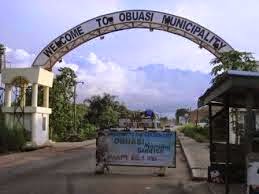
Bumps in the Road: Ghana District Explores Impact of Mining on Local Economy
The bumpy road leading to the gold town of Obuasi in the Ashanti region depicts the worrying state of an area that has played a significant role in Ghana’s economic development. For over 100 years, mining in Obuasi has been a major contributor to the country’s foreign exchange earnings. For each of the past five years, mining in Obuasi contributed an average of $2 billion in government revenue.
Mining communities, however, complain the industry has failed to deliver tangible benefits for local people. “They should hear the communities cry,” said Madam Gifty Owusu Afriyie, who represents the Tutuka Central electoral area in the Obuasi Municipal Assembly. “Children and women are suffering because they have to travel a long way before they can fetch some water.” Concerns are rife that the government has used up revenue from mining without addressing the development challenges of local mining communities.

Photo Courtesy of the Author
In response, the Natural Resource Governance Institute (NRGI) organized a two-day national workshop with the Center for Social Impact Studies (CeSIS) and Ghana Extractive Transparency Initiative (GHEITI) to analyze the country’s subnational revenue management, as reported on by the Extractive Industries Transparency Initiative (EITI). Together representatives from the Mineral Commission, district assemblies, Anglogold Ashanti Ltd., civil society organizations, local authorities and media discussed the benefits and challenges of mining for local communities. Using EITI data, CeSIS presented its analysis of the mining benefits flowing to Obuasi. Discussion on the research focused on how the EITI Standard should better capture benefits flowing to subnational jurisdictions in Ghana, as well as how Obuasi should move forward.
Data driven development
In Ghana, district assemblies, traditional councils and stool lands (local kingdoms) receive a total of 8 percent of royalty revenues from the central government. For district assemblies, these royalties and property rates, which they collect directly from mining companies, comprise more than 20 percent of their annual revenues. At the workshop, participants discussed loopholes in EITI reporting and revenue collection and spending by Obuasi District. Even spending by local assembly authorities was in question. For instance, in 2007 the Obuasi Municipal Assembly constructed the Obuasi Entrance Arch at a cost of Ghana Cedis 89,000 (about $26,000)—funds that could have purchased a good road network, potable water, quality healthcare and education, locals say.
“If there is any community in Ghana where we all need to be concerned about the impact of mining, it’s Obuasi, especially in this moment when [AngloGold Ashanti] is in its critical state,” noted Emmanuel Kuyole, NRGI’s Africa regional coordinator. AngloGold has put the Obuasi mine under what is termed as “care and maintenance,” following recent operational losses. Over 5000 workers have lost their jobs. Only 500 to 600 remain.
The two-year break is expected to cripple the ability of the Obuasi Municipal Assembly to generate enough revenue to finance local development projects. As much as 70 percent of the assembly’s total property rate mobilization comes from AngloGold Ashanti. “We’re looking into how we can take advantage of the number of years that is left for mining to take place in Obuasi to actually develop a local economy that will be independent of the mine, so that we can find jobs and grow other sectors and make sure that once mining comes to an end, the economy of this great place will also not come to an end,” added Mr. Kuyole.
Kofi Adu Domfeh is the manager of the business desk and digital content at Luv 99.5 FM, as well as a reporter for Joy 99.7 FM and UK-based WREN Media. He is also an alumnus of NRGI’s 2014 course, “Strengthening Media Oversight of the Extractive Sectors.”
This article was published previously on the author’s blog and has been edited.
